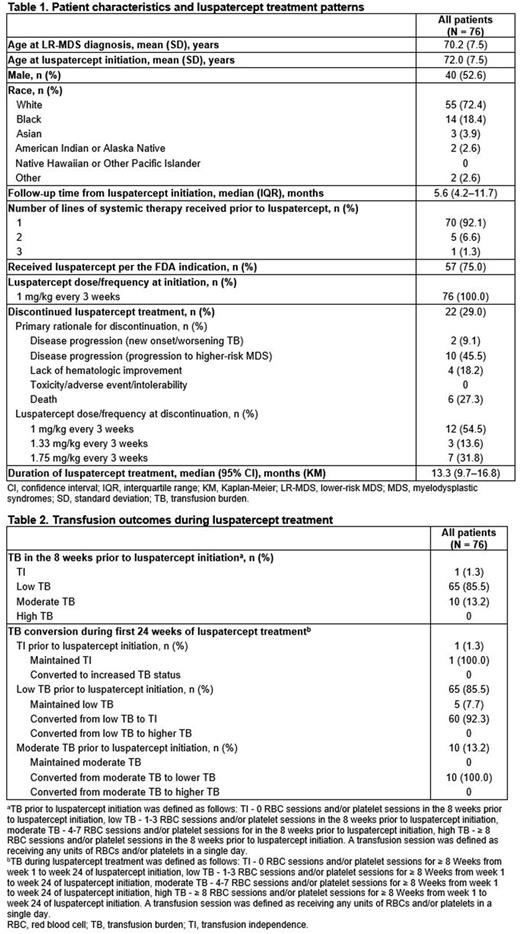Abstract
Introduction: LR-MDS is characterized by ineffective hematopoiesis, cytogenic and molecular abnormalities, progressive bone marrow failure, ≥ 1 cytopenias, and variable risk of progression to acute myeloid leukemia. Patients (pts) may be classified as having LR-MDS based on an International Prognostic Scoring System (IPSS) score of Low or Intermediate risk and/or an IPSS-Revised (IPSS-R) score of Very Low, Low, or Intermediate risk. Erythropoiesis-stimulating agents (ESAs) are the first line of treatment for most pts with LR-MDS. However, many pts experience ESA failure and have limited subsequent treatment options. Luspatercept is a first-in-class erythroid maturation agent approved by the US FDA in April 2020 for the treatment of anemia following ESA failure and requiring ≥ 2 red blood cell units over 8 weeks in adult pts with LR-MDS with ring sideroblasts (RS) or with MDS/myeloproliferative neoplasms with RS and thrombocytosis. Limited evidence exists on treatment patterns and outcomes among pts with LR-MDS treated with luspatercept in routine clinical practice. The aim of this study was to examine pt characteristics, treatment patterns, and transfusion outcomes among pts with LR-MDS treated with luspatercept in the real-world setting.
Methods: This was a retrospective, observational cohort study using physician-abstracted data from the charts of adults diagnosed with LR-MDS on or after January 1, 2015, who received luspatercept treatment in US clinical practice. Pts ≥ 18 years old with LR-MDS who received luspatercept for ≥ 3 months and had ≥ 3 months of follow-up after starting luspatercept (or until death if within 3 months of luspatercept initiation) were included. Pts were classified as having LR-MDS based on their IPSS-R or IPSS scores at diagnosis. Pts who participated in a clinical trial were excluded. All data were summarized using descriptive statistics.
Results: A total of 76 eligible pts were included; 52.6% were male, 72.4% were White, and the mean age at luspatercept treatment initiation was 72.0 years (Table 1). Median follow-up time from luspatercept initiation was 5.6 months. Nearly all pts (92.1%) received only 1 line of systemic treatment for LR-MDS before receiving luspatercept. All pts initiated luspatercept treatment at the approved starting dose of 1 mg/kg every 3 weeks, and 75.0% of pts received luspatercept according to the approved US FDA indication. Based on Kaplan-Meier estimates, the median duration of luspatercept treatment was 13.3 months. Twenty-two pts (29.0%) discontinued luspatercept treatment during the follow-up period, of whom 54.5% discontinued on the same dose as their starting dose, ie, 1 mg/kg every 3 weeks (68.2% discontinued at a dose < 1.75 mg/kg) (Table 1). Disease progression to higher-risk MDS was the most common reason for luspatercept discontinuation (n = 10/22, 45.5%). No pts discontinued treatment due to adverse events. At luspatercept initiation, 85.5% of pts had low transfusion burden (TB), of whom 7.7% maintained low TB and 92.3% converted from low TB to transfusion independence (TI) during the first 24 weeks of luspatercept treatment (Table 2). Moderate TB was present in 13.2% of pts at luspatercept initiation, all of whom transitioned to having lower TB during the first 24 weeks of luspatercept treatment.
Conclusions: This real-world chart review study showed > 90% of pts with low TB prior to luspatercept initiation achieved TI within the first 24 weeks of luspatercept treatment. All pts with moderate TB prior to luspatercept had a decrease in level of TB within the first 24 weeks of starting luspatercept treatment. The MEDALIST trial showed 38% of pts treated with luspatercept- with IPSS-R Very Low to Intermediate risk reached TI within 24 weeks (Fenaux P, et al. N Engl J Med 2020;382:140-151). The present study suggests that initiating luspatercept for low or moderate TB may have a substantial impact on TB and merits continued attention as experience with luspatercept in clinical practice accumulates. Among those who discontinued luspatercept treatment, more than half discontinued at the starting dose. Luspatercept dose titration in real-world clinical practice may not align with recommended dose increases according to the approved US indication. This discrepancy represents an unmet clinical need and potential area for further clarification and education in the community setting.
Disclosures
Mukherjee:McGraw Hill Hematology Oncology Board Review: Honoraria, Other: Advisor or review panel participant; Genentech: Membership on an entity's Board of Directors or advisory committees; BMS: Consultancy, Honoraria, Membership on an entity's Board of Directors or advisory committees, Other: Advisor or review panel participant, Research Funding; AbbVie: Membership on an entity's Board of Directors or advisory committees, Other: Advisor or review panel participant; BioPharm: Consultancy; Aplastic Anemia and MDS International Foundation: Honoraria; Celgene/Acceleron: Consultancy, Honoraria, Membership on an entity's Board of Directors or advisory committees, Other: Advisor or review panel participant, Research Funding; Blueprint Medicines: Membership on an entity's Board of Directors or advisory committees, Other: Advisor or review panel participant; Partnership for Health Analytic Research, LLC: Honoraria; Novartis: Consultancy, Membership on an entity's Board of Directors or advisory committees, Other: Advisor or review panel participant, Research Funding; Jazz Pharmaceuticals: Other: Principal investigator for Investigator Initiated Trials (the Institution gets the funding), Research Funding; Eusa Pharma: Consultancy, Other: Advisor or review panel participant; Teaching and Speaking. Brown-Bickerstaff:Cardinal Health: Current Employment. McBride:BMS: Current Employment. Gajra:Cardinal Health Specialty Solutions: Consultancy, Current Employment, Current equity holder in publicly-traded company; Astra Zeneca: Consultancy, Honoraria; Cellectar: Consultancy, Honoraria. Gentile:Cardinal Health: Current Employment. Falkenstein:Cardinal Health Specialty Solutions: Current Employment. Miller:Cardinal Health: Current Employment. Laney:Cardinal Health: Current Employment. Savill:Bayer: Consultancy; Astra Zeneca: Consultancy; Janssen: Consultancy; Morphosys: Consultancy; Incyte: Consultancy; Pfizer: Consultancy; Daiichi Sankyo: Consultancy; Genentech: Ended employment in the past 24 months; Cardinal Health: Current Employment, Current holder of stock options in a privately-held company. Makinde:Bristol Myers Squibb: Current Employment, Current equity holder in publicly-traded company.
Author notes
Asterisk with author names denotes non-ASH members.


This feature is available to Subscribers Only
Sign In or Create an Account Close Modal